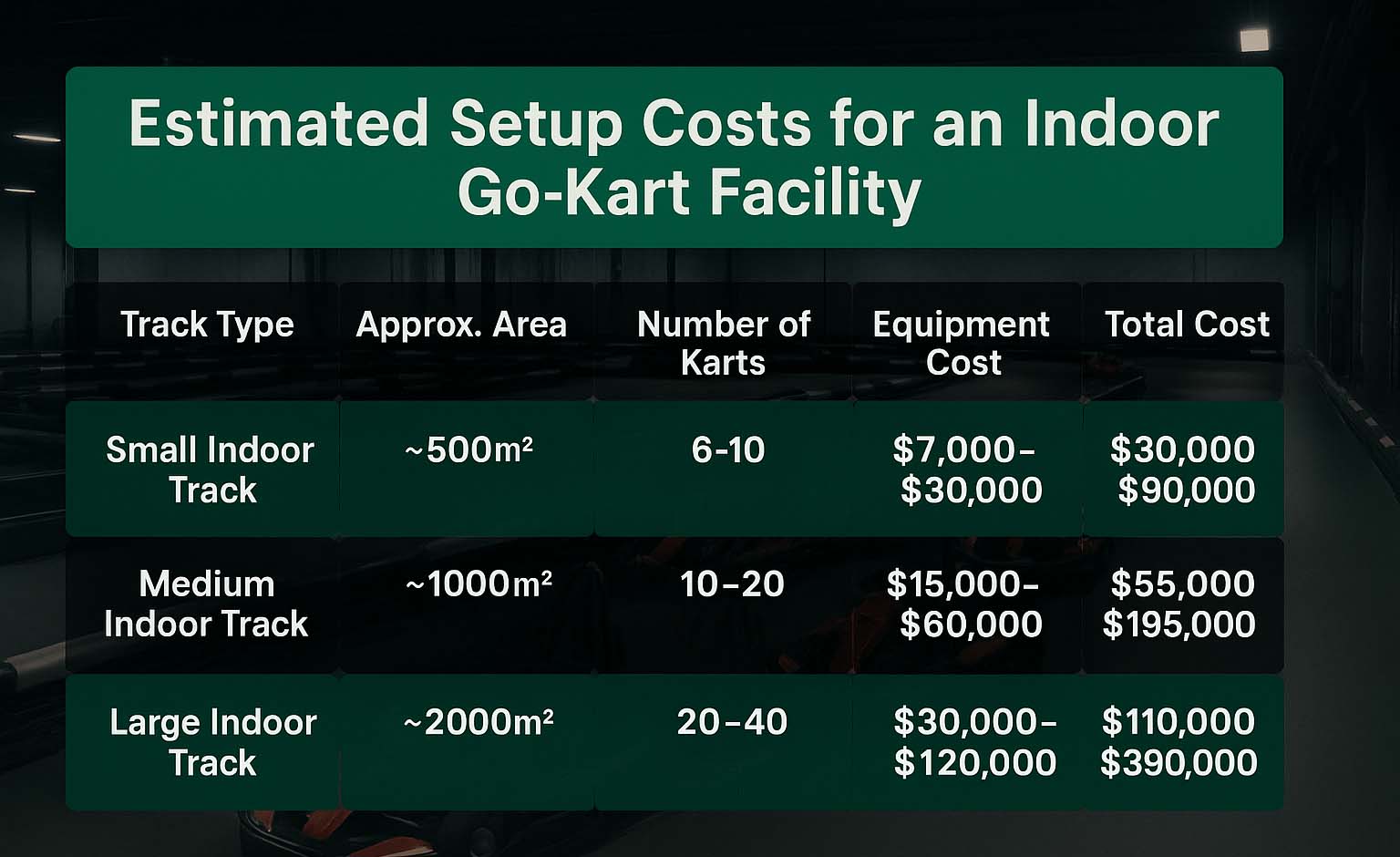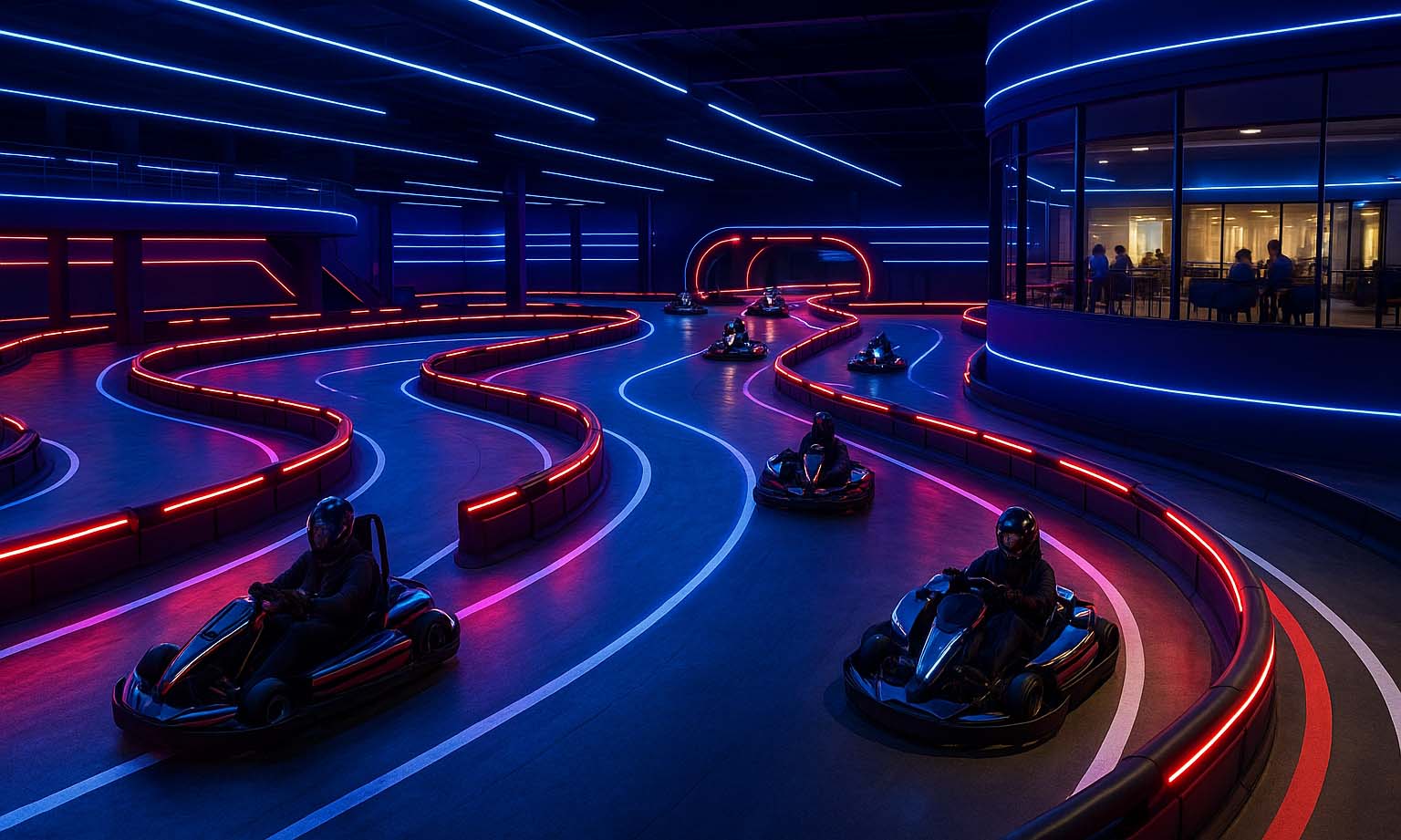Starting a go-kart business is one of the most exciting opportunities in today’s entertainment market.
It combines fun, competition, and technology — appealing to both kids and adults alike.
But before opening your track, there’s one question every investor asks:
“How much does it really cost to start a go-kart business?”
This guide provides a realistic breakdown of startup costs, especially for indoor electric go-kart tracks, now the most popular format worldwide.
We’ll separate equipment costs (fixed and provided by the manufacturer) from venue preparation costs (handled locally by the customer), so you can plan your investment clearly.
1. Main Investment Components
Launching a go-kart project typically involves two main categories of spending:
A. Equipment Costs (Fixed and Predictable)
This is your primary procurement expense — the go-karts and essential systems supplied by the manufacturer.
The pricing is transparent and depends mainly on the number of karts and your track layout.
A complete package usually includes:
-
Electric Go-Karts: $1,400 – $4,200 per unit (depending on battery and motor power)
-
Charging and Control System: $4,000 – $8,000 per track
-
Safety Barriers and Track Accessories: $10,000 – $18,000 — learn more about our safety barrier and track protection systems for reliable operation.
-
Timing & Management System (optional): $2,000 – $5,000
Example: For a 500㎡ indoor track with 6–10 karts, the equipment cost typically ranges from $24,000 to $67,000.
B. Venue & Renovation Costs (Variable and Local)
This cost depends on your location, labor rate, and decoration level.
Customers normally handle this part by hiring local contractors.
Typical renovation items include:
-
Flooring or epoxy track surface
-
Lighting and ventilation systems
-
Ticket counter and waiting area
-
Restrooms and basic interior design
Estimated budgets by region:
-
Southeast Asia: $7,000 – $15,000
-
Middle East / Eastern Europe: $20,000 – $40,000
-
Western Europe / USA: $50,000 – $70,000+
These expenses are not included in the manufacturer’s equipment quote, as they vary widely depending on local conditions.
2. Investment Scenarios by Scale

Understanding the Three Cost Columns
Equipment Cost: Fixed pricing for go-karts, chargers, and barriers — purchased directly from the manufacturer.
+ Renovation (Local): Venue preparation done by the customer, based on local costs.
≈ Total Investment: The combined estimated total for both parts (rent not included).
| Scale | Track Size | Karts | Equipment Cost | + Renovation (Local) | ≈ Total Investment |
|---|---|---|---|---|---|
| Small Indoor Track | ~500㎡ | 6–10 | $24,000–$67,000 | +$7,000–$30,000 | ≈ $30,000–$90,000 |
| Medium Track | 2000–3000㎡ | 15–20 | $50,000–$130,000 | +$20,000–$60,000 | ≈ $70,000–$190,000 |
| Large Track / FEC | 5000㎡+ | 25–30+ | $90,000–$220,000 | +$50,000–$100,000+ | ≈ $140,000–$300,000+ |
Before deciding on your track size, it’s helpful to compare the differences between indoor and outdoor go-kart investments to find which model fits your market and budget best.
3. Hidden and Long-Term Costs to Consider
Startup investment is only part of the story. Running a go-kart business involves ongoing expenses that you should also plan for.
Battery Replacement
Lithium batteries last around 3–5 years, with replacement costs of $500–$1,000 per kart.
Maintenance & Spare Parts
Annual maintenance (tires, brakes, paint, repairs) usually accounts for 5–10% of your total equipment cost.
For a deeper breakdown of maintenance, energy consumption, and spare part replacement, see our Go-Kart Maintenance and Operating Cost Guide.
Staffing & Management
Hiring attendants, technicians, and reception staff costs roughly $3,000–$8,000 per month, depending on region and labor rates.
Insurance and Permits
Commercial entertainment venues require insurance and operating permits.
Expect $5,000–$15,000 annually, depending on venue size and location.
Marketing and Promotion
Allocate 5–10% of monthly revenue for online ads, influencer marketing, and events to keep traffic steady.
Venue Rent (Location-Dependent)
Rent is one of the most variable expenses in your budget:
-
In shopping malls or downtown areas, rent can be substantial.
-
In suburban or industrial zones, rent may be far cheaper.
-
Some operators partner with malls or resorts, reducing rent in exchange for attracting visitors.
Because rent differs dramatically worldwide, it’s not included in the setup cost shown above.
However, plan for 3–6 months of rent as part of your startup capital to ensure financial stability after opening.
4. How to Control Startup Costs
1. Start Small and Scale Gradually
Begin with 6–8 karts in a 500–800㎡ area. This allows you to test the market before expanding.
2. Choose Standardized Designs
Custom track designs increase cost. Standard layouts save time, materials, and engineering fees.
3. Buy Directly from the Manufacturer
Direct purchase ensures fair pricing, warranty, and access to after-sales support without middlemen markups.
4. Invest in Reliable Quality
High-quality electric go-karts and safety systems reduce downtime and repairs — improving ROI in the long term.
Want to know how long it takes to recover your investment? Try our Go-Kart ROI Calculator and Payback Analysis for a realistic financial projection.
5. Example: Entry-Level Indoor Track Setup
| Item | Description | Estimated Cost (USD) |
|---|---|---|
| 6–8 Electric Go-Karts | Brushless motor, 24V/500W | $10,000 – $25,000 |
| Charging & Control System | Includes chargers & remote stop | $4,000 – $6,000 |
| Safety Barriers & Accessories | Track fences, cones, padding | $10,000 – $15,000 |
| Basic Venue Work | Floor coating, lighting, signage | $7,000 – $15,000 |
| Total | $30,000 – $60,000 |
If you want to upgrade your track with interactive technology, consider our Mixed Reality Go-Kart Business Guide to see how MR racing can attract more players and boost profits.
6. Why Electric Go-Karts Are the Smarter Choice
Electric go-karts are increasingly replacing gas-powered models. Learn more about their technology and business advantages in our Electric Go-Kart Business Guide.
They’re:
-
Eco-friendly: Zero emissions and no fuel smell.
-
Low Maintenance: Fewer moving parts, no engine oil or spark plugs.
-
Quiet and Family-Friendly: Perfect for indoor use.
-
Smart Control: Adjustable speeds and remote safety shutdown.
Although the purchase cost is slightly higher than gas karts, the operational savings are much greater — making electric go-karts the most profitable long-term option.
7. Conclusion
So, how much does it really cost to start a go-kart business?
-
Small indoor track: $30,000–$90,000
-
Medium track: $70,000–$190,000
-
Large FEC track: $140,000–$300,000+
The equipment cost is fixed and predictable, while venue and rent costs depend on your location.
By starting small, sourcing equipment directly from a manufacturer, and expanding gradually, you can build a profitable and sustainable go-kart business with a reasonable budget.
For more detailed planning, explore our Complete Go-Kart Business Guide Hub covering design, operation, ROI, and marketing strategies.

